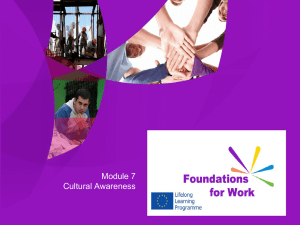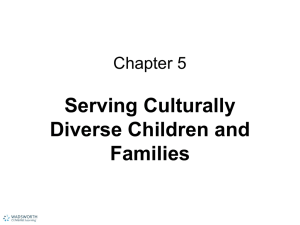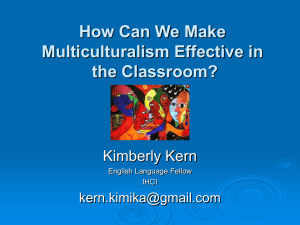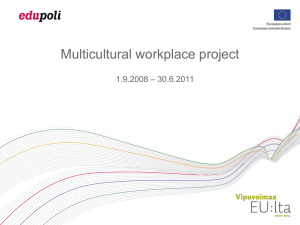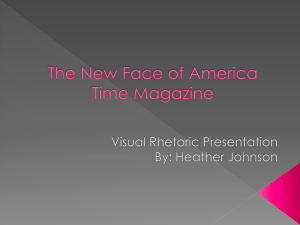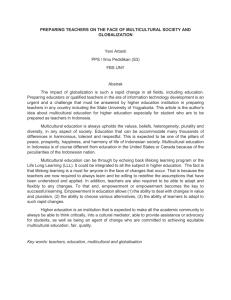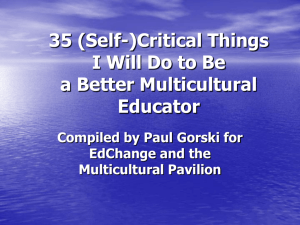File - Charlene Andazola`s Education Portfolio
advertisement
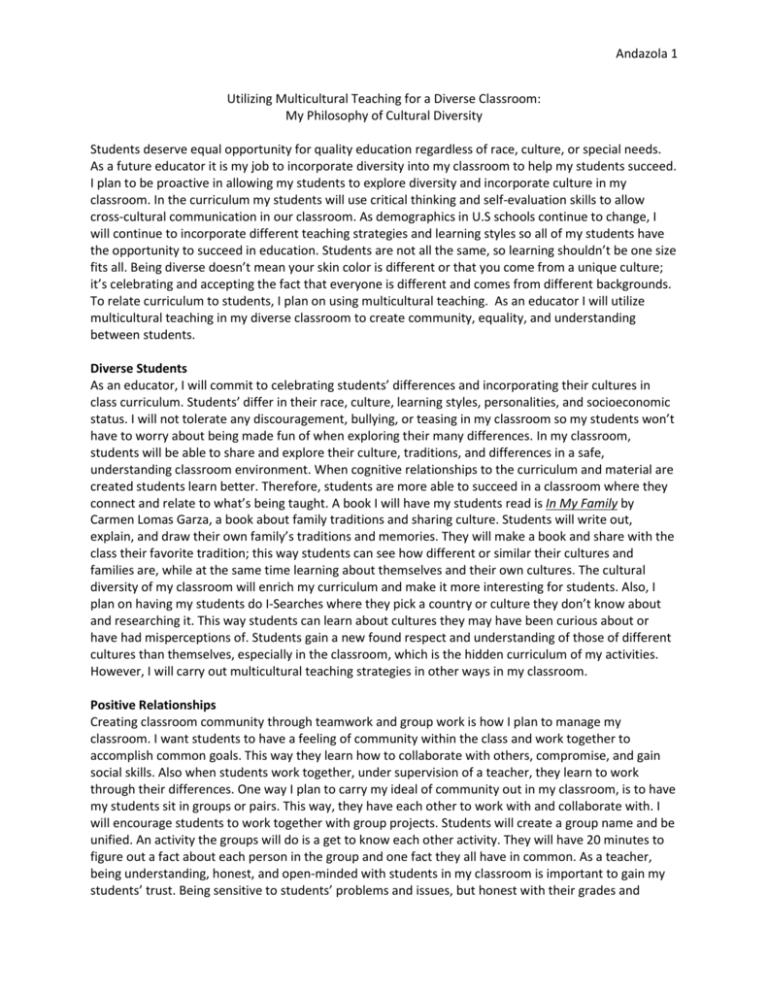
Andazola 1 Utilizing Multicultural Teaching for a Diverse Classroom: My Philosophy of Cultural Diversity Students deserve equal opportunity for quality education regardless of race, culture, or special needs. As a future educator it is my job to incorporate diversity into my classroom to help my students succeed. I plan to be proactive in allowing my students to explore diversity and incorporate culture in my classroom. In the curriculum my students will use critical thinking and self-evaluation skills to allow cross-cultural communication in our classroom. As demographics in U.S schools continue to change, I will continue to incorporate different teaching strategies and learning styles so all of my students have the opportunity to succeed in education. Students are not all the same, so learning shouldn’t be one size fits all. Being diverse doesn’t mean your skin color is different or that you come from a unique culture; it’s celebrating and accepting the fact that everyone is different and comes from different backgrounds. To relate curriculum to students, I plan on using multicultural teaching. As an educator I will utilize multicultural teaching in my diverse classroom to create community, equality, and understanding between students. Diverse Students As an educator, I will commit to celebrating students’ differences and incorporating their cultures in class curriculum. Students’ differ in their race, culture, learning styles, personalities, and socioeconomic status. I will not tolerate any discouragement, bullying, or teasing in my classroom so my students won’t have to worry about being made fun of when exploring their many differences. In my classroom, students will be able to share and explore their culture, traditions, and differences in a safe, understanding classroom environment. When cognitive relationships to the curriculum and material are created students learn better. Therefore, students are more able to succeed in a classroom where they connect and relate to what’s being taught. A book I will have my students read is In My Family by Carmen Lomas Garza, a book about family traditions and sharing culture. Students will write out, explain, and draw their own family’s traditions and memories. They will make a book and share with the class their favorite tradition; this way students can see how different or similar their cultures and families are, while at the same time learning about themselves and their own cultures. The cultural diversity of my classroom will enrich my curriculum and make it more interesting for students. Also, I plan on having my students do I-Searches where they pick a country or culture they don’t know about and researching it. This way students can learn about cultures they may have been curious about or have had misperceptions of. Students gain a new found respect and understanding of those of different cultures than themselves, especially in the classroom, which is the hidden curriculum of my activities. However, I will carry out multicultural teaching strategies in other ways in my classroom. Positive Relationships Creating classroom community through teamwork and group work is how I plan to manage my classroom. I want students to have a feeling of community within the class and work together to accomplish common goals. This way they learn how to collaborate with others, compromise, and gain social skills. Also when students work together, under supervision of a teacher, they learn to work through their differences. One way I plan to carry my ideal of community out in my classroom, is to have my students sit in groups or pairs. This way, they have each other to work with and collaborate with. I will encourage students to work together with group projects. Students will create a group name and be unified. An activity the groups will do is a get to know each other activity. They will have 20 minutes to figure out a fact about each person in the group and one fact they all have in common. As a teacher, being understanding, honest, and open-minded with students in my classroom is important to gain my students’ trust. Being sensitive to students’ problems and issues, but honest with their grades and Andazola 2 teaching curriculum. To not sugar coat human rights, civil rights, or current issues. They deserve to hear the truth; if teachers are honest with students they’ll be honest with their teachers. Furthermore, I will demonstrate multicultural teaching through curriculum. Multicultural Curriculum Being flexible in my teaching to accommodate my varying students, but not to hinder challenging my students’ intellect. Not every student learns the same way, but when accommodating curriculum to students who may learn a different way, I will make sure the curriculum teaches and holds my students to the same expectations. In order to accommodate to my students I will incorporate varying learning styles in my classroom, also known as differentiated instruction. One example, is when learning spelling words I will have my students write the words three times and use the words in a sentences. As well as, say and spell the words out loud and use flash cards to study them. This way students get all forms of learning styles, like visual, oral, and kinesthetic learning. However, having realistic and high expectations for my students and motivate them to succeed in their educational goals. Being supportive of students is a characteristic teachers should have, so their students succeed. Students need support and motivation to grow. One way I plan to help my students achieve is by holding tutoring students during lunch or after school in subjects they may need help improving in or just help with their homework. Lastly, my own dispositions are important for multicultural teaching. Dispositions of a Multicultural Educator As a teacher, coming into work with a positive attitude and being patient are a necessity to students’ success in the classroom if their teacher shows they like their job. They’ll feel more comfortable and safe in their classroom environment. I will be patient with my students and be positive and optimistic. Furthermore, not having any prejudices, biases, or inequality in my classroom are vital in allowing my students a fair and equal educational experience. I understand I will have my own biases, but I will selfreflect and build stronger student-teacher relationships. With my students, they deserve equal opportunity and accessibility in education. I will not turn away a student in need or refuse to help a student. As a respect to my students, I use people first language. Instead of saying, “The autistic student…” I will correct myself or say, “The student who is diagnosed with autism.” This way my students understand I respect them and treat them fairly. As an educator, I plan to stay committed to my students and encouraging them to explore culture and accept diversity. Diversity is all around students in the world, I want my students to have open minds and accept diversity. As a role model for my students, I must set an example of a fair, understanding educator who appreciates every one of them.
